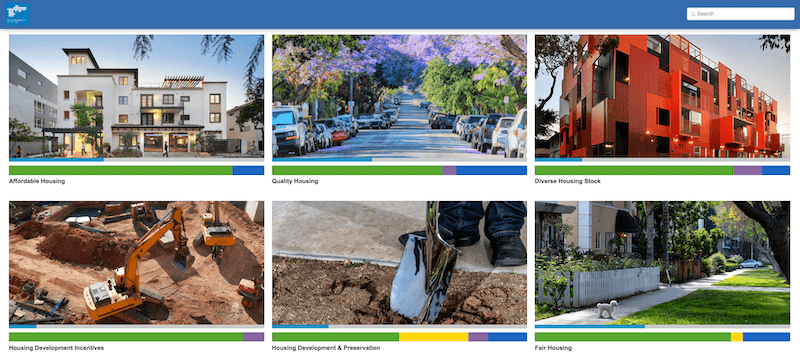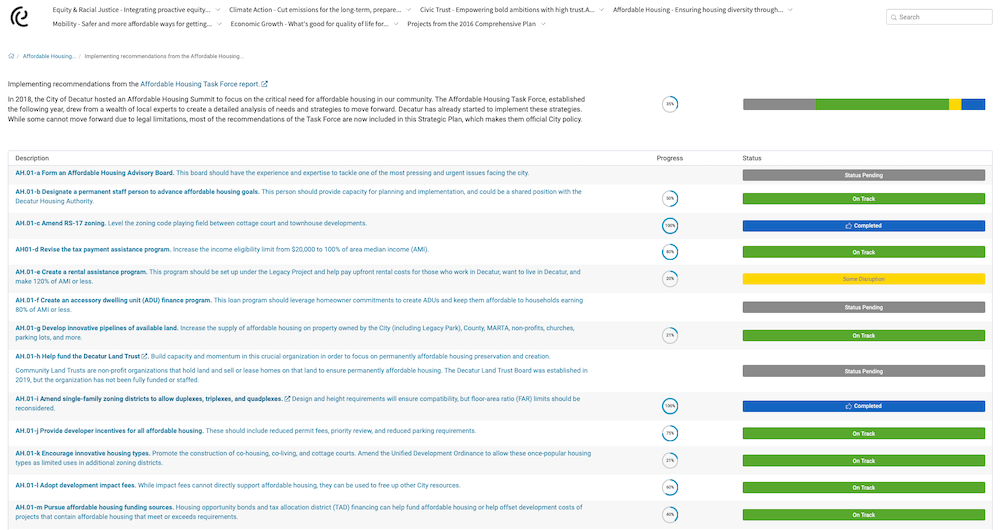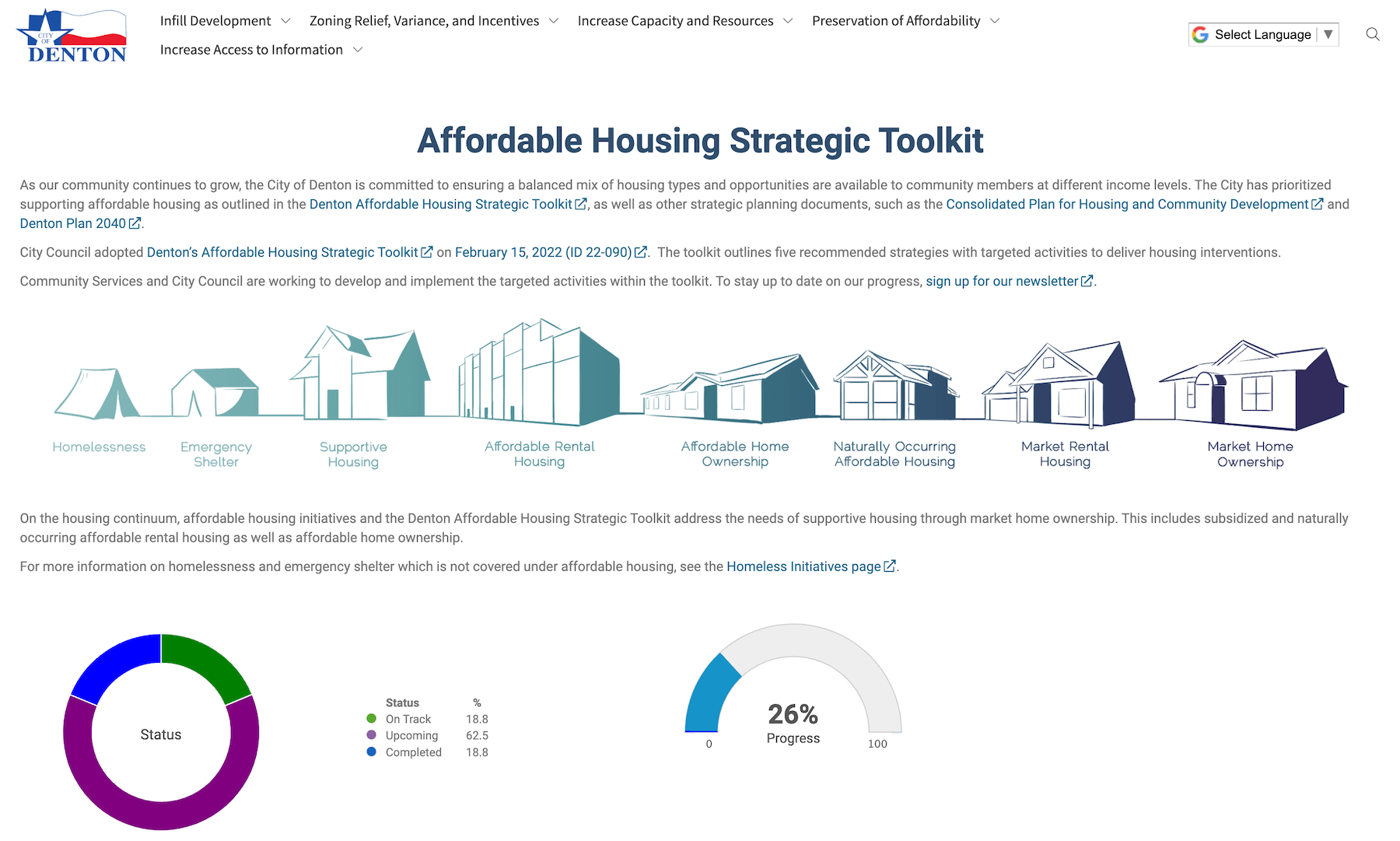
Contents
- 1 Affordable housing plans: Performance measures and strategic goals
- 2 Affordable housing plans: West Hollywood’s Housing Element Policy (California)
- 3 Affordable housing plans: City of Decatur’s Strategic Plan (Georgia)
- 4 Affordable housing plans: City of Denton’s Strategic Toolkit (Texas)
- 5 Affordable housing plans: New Dawn Enterprises’ Supportive Housing Projects (Nova Scotia)
- 6 Get the guide ↓
Affordable housing is a major barrier to achieving economic security, and it has been a growing crisis in North America for decades. Renters in Canada and the United States—and specifically those with low incomes—encounter significant challenges in securing housing. According to the National Low Income Housing Commission, in a report published in 2023, in the United States, there is a deficit of 7.3 million available and affordable rental homes for individuals in the low income demographic, representing an 8 percent increase from 2019. This scarcity is particularly acute for Black, Latinx, and Indigenous households. Data shows that households with extremely low incomes in Nevada, Oregon, Florida, California, Arizona, and Texas experience the most severe housing shortages. Renters in this income brackets also endure severe housing cost burdens when they do get housing: costly repairs, inefficient energy bills, utilities—allocating more than 50 percent of their income to housing expenses.
In Canada, the statistics are similarly striking; 2021 census data indicated that millions of homes in Canada are facing issues such as damage, overcrowding, or unaffordability for their residents. Approximately one in six homes owned by their occupants were deemed unaffordable, in contrast to one in three among homes rented by their occupants.
In the United States, there is a deficit of 7.3 million available and affordable rental homes for individuals in the low income demographic.
Housing is a pressing crisis everywhere, and we have reached a point where leaders are recognizing the critical need for accessible and affordable living options, responding with policies to address housing disparities within their communities.
In this blog post, we will talk about affordable housing plans as a positive trend for local governments, examine examples of affordable housing performance measures and strategic plans from our local government customer base, and take a look at a few affordable housing dashboards. These are all part of affordable housing strategies that local governments might employ to ensure their community is safe, housed, and happy: that’s what we want to see!
Affordable housing plans: Performance measures and strategic goals
Housing is a basic human right, and the cornerstone of vibrant, diverse, and inclusive communities. According to the National Collaborating Centre for Determinants of Health, housing is indeed a determinant of health, woven through a complex network of elements such as affordability, access, availability, habitability, stability, and socioeconomic disparities. A safe place to call home is a major catalyst for improved health, education, and employment outcomes, making it a linchpin for the overall well-being of a community.
In general, when we’re talking about big community goals such as increasing access to housing, being able to break them down and tie them to actions and a budget is key to implementation. To effectively address the affordable housing crisis, local governments must implement robust performance measures alongside their strategic goals. Tracking progress is essential for ensuring that policies are effective and responsive to the evolving needs of the community.
Some key performance measures and strategic goals for affordable housing plans could include:
Affordability Metrics:
- Percentage of income spent on housing by residents.
- Ratio of affordable housing units to the total housing stock.
Inclusionary Zoning Policies:
- Implement and evaluate the success of inclusionary zoning policies to mandate a percentage of new developments as affordable housing.
Community Engagement:
- Measure the level of community engagement and feedback in the development and implementation of affordable housing policies.
Accessibility and Transit-Oriented Development:
- Promote housing developments that are easily accessible to public transportation, reducing residents’ reliance on personal vehicles.
Preservation of Affordable Housing:
- Establish goals for the preservation and rehabilitation of existing affordable housing units.
All of the plans we’ve included here use these performance measures in some capacity, to guide them towards a tangible goal of affordable housing. Let’s take a closer look at a few affordable housing plans and dashboards, and see these strategies in action.
Affordable housing plans: West Hollywood’s Housing Element Policy (California)
West Hollywood stands out as a shining example of a municipality committed to addressing housing affordability. They are tackling all types of issues related to housing, and their affordable housing plan is developed within their Housing Element policy guide, as well as being intertwined with other policies.
They measure transit-orientedness, affordability metrics, and existence of current laws that may (or may not) protect renters and low or middle income workers. This holistic approach of tackling a big problem by placing carefully selected actions across departments is a big part of why we love this plan.
The city’s Housing Element policy, covering the period from 2021 to 2029, outlines a comprehensive strategy to meet the housing needs of its residents. Key components of the policy that directly impact affordability include:
Diverse housing types:
- Encouraging the development of a diverse range of housing types, including affordable, supportive, and workforce housing.
Housing development incentives:
- Making housing development decisions based on other factors in urban planning, such as public transit availability and other infrastructure needs.
Prioritizing fair housing:
- Promoting establishment of “missing middle” housing, workforce related housing, and community housing.
- Establishing renter protections and landlord/tenant mediations.
- Developing community land trusts.
With regards to their affordable housing strategic pillar, West Hollywood is particularly focused on the limited housing choices available to lower income people—and especially, concerns about possible displacement, eviction, or homelessness among already vulnerable individuals. This strategic objective is aimed towards safeguarding the current inventory of reasonably priced rental housing and enhancing opportunities for affordable housing. The plan recognizes and attempts to reconcile many dimensions of the current housing crisis: promoting tenant safety and implementing rent stabilization ordinances, checking on vacancy de-control regulations, promoting the substitution of demolished multifamily housing, and reevaluating zoning policies that negatively impact affordability.
West Hollywood is particularly focused on the limited housing choices available to lower income people—and especially, concerns about possible displacement, eviction, or homelessness among already vulnerable individuals.
It’s no secret that Los Angeles County has some of the most notorious housing costs in the world—right up there with Hong Kong, Toronto, Vancouver, New York City, and Paris. West Hollywood, as a municipality within the county, is trying to shake off this reputation through their strategic plan. The reality of facing the lack of affordable long-term housing involves acknowledging laws or ordinances that have favored short-term rentals, or the displacement of residents. West Hollywood’s recent housing plan tackles these areas in an effort to create an economically and socially diverse community that can afford to stay where they are.
Affordable housing plans: City of Decatur’s Strategic Plan (Georgia)
Decatur, Georgia’s Destination 2030: Strategic Plan diverges from past city plans in its structure and focus. In the past, Decatur focused on more broad and sweeping analyses of the changes they wanted to make in their community. Their new strategic plan is all about focus and specificity. They gathered performance measures, ideas, and goals from lively community discussions, and broke them down into six themes that emerged. These themes organized the policies and action items that encapsulate the entire plan. The result? A strategic plan that is grounded in facts, community, and context.
Affordable housing emerged as one of the six community priorities, and local government leaders are listening. Affordable housing is therefore one of the main strategic pillars in their strategic plan. Their action items on affordability are tied back to the budget, and are intricately connected to the overarching plan, creating a dynamic framework for the city’s growth.
In 2018, Decatur held an Affordable Housing Summit to spotlight the pressing demand for affordable housing within the community. The subsequent year witnessed the formation of the Affordable Housing Task Force, tapping into the expertise of local professionals to analyze needs and devise strategies for progress. Implementation of these strategies is already underway in Decatur. Recommendations include amending zoning bylaws, creating a rental assistance program, providing developer incentives for affordable housing, and strengthening relationships with local non-profits, the Decatur Housing Authority, and other entities, to share wisdom, ideas, and data.
In 2018, Decatur held an Affordable Housing Summit to spotlight the pressing demand for affordable housing within the community. The subsequent year witnessed the formation of the Affordable Housing Task Force, tapping into the expertise of local professionals to analyze needs and devise strategies for progress.
What we like about this affordable housing plan is that the focus extends beyond mere shelter, aligning with goals of equity and diversity. Decatur is particularly concerned about the over-representation of Black families facing displacement due to rising living costs, leading to economic disparity being disproportionately racialized. Decatur’s plan also involves strategically ensuring affordable housing also includes the convenience of public transit, as well as biking and walking, promoting accessibility and a lowered carbon footprint.
Affordable housing plans: City of Denton’s Strategic Toolkit (Texas)
The City of Denton’s Affordable Housing Toolkit responds to the increasing need for varied housing possibilities, and outlines five primary housing priorities:
- Infill development opportunities: Refers to the construction of new buildings on new or under-utilized land.
- Zoning relief, incentives, and variances: Adjusts regulations and provides incentives to encourage private-sector developments to develop more affordable housing.
- Increased capacity and resources: This covers grant assistance, technical assistance, financing, and promotes partnerships in order to achieve economic sustainability.
- Preservation of affordability: Ensures existing affordable housing is preserved and expanded.
- Increase access to information: Ensuring safe and healthy housing for all Denton families involves making information available, by linking to community services, creating interactive mapping tools, and educational legal outreach for landlords and tenants.
Denton has prioritized data-driven housing plans, which can be challenging. We’ve talked about why it’s so important to prioritize understanding and sharing the facts about a community—even when it shows something unfavorable. Facing the numbers is the first step to improving a situation.
Like many cities across the United States, Denton has witnessed a significant increase in both home prices and rent in recent years. Denton faces a shortage of housing options at low and moderate price points, and this scarcity has placed a financial burden on the lower-wage workforce and young professionals in the community. As they outline in their Affordable Housing Strategic Toolkit, an individual renting a market-rate one-bedroom unit would need an annual income of $45,000, while a household seeking a median-priced home would require an income of $75,000. As of 2021, anyone earning less than these thresholds (which often includes essential workers such as hospital staff, city employees, or grocery store workers) will find it difficult to afford housing in Denton.
We’ve talked about why it’s so important to prioritize understanding and sharing the facts about a community—even when it shows something unfavorable. Facing the numbers is the first step to improving a situation.
That’s why the city’s affordable housing plan has a focus on economically viable development projects, with a focus on infill development. One of their upcoming action items is to establish guidelines and regulations that empower both the private market and non-profit collaborators to construct housing for households earning below 80% of the Area Median Income (AMI) with reduced subsidies.
Affordable housing plans: New Dawn Enterprises’ Supportive Housing Projects (Nova Scotia)
New Dawn is not technically a local government organization. However, they receive their funding projects from federal and provincial initiatives, and they are filling a gap of housing access that has been widening in Nova Scotia for a long time.
New Dawn Enterprises is working on a supportive affordable housing project comprising 25 units, funded by the federal Rapid Housing Initiative (RHI), Reaching Home, and the Province of Nova Scotia. New Dawn is a community development corporation aimed towards establishing supportive cultures of self-reliance, and they are particularly passionate about supporting seniors and people living with disabilities.
Their housing initiative is dedicated towards addressing a gap in housing in Nova Scotia; namely, offering safe, secure, and aesthetically pleasing homes for individuals facing the most precarious housing situations in the community. Their Envisio-powered public dashboard reflects their development projects.
One thing we love about this dashboard is that it is embedded within New Dawn’s website, making it super easy to find. But the other thing we like is the transparency around each of the projects; where the funding comes from and exactly what it’s going towards. The New Dawn team has clearly outlined each strategic action and the progress made towards goals–in their section on programming and support, for example, they refer to the fact that they can use other supportive housing projects as benchmarks and inspiration for their own programs. Ensuring necessary resources are available to a community is a critical part of ensuring any affordable or subsidized housing project is sustainable, and that is the careful work they are engaging in.
[New Dawn’s] housing initiative is dedicated towards addressing a gap in housing in Nova Scotia; namely, offering safe, secure, and aesthetically pleasing homes for individuals facing the most precarious housing situations in the community.
–
The trend towards prioritizing affordable housing in local governments and public sector organizations signifies a much-needed and timely shift towards more inclusive, equitable, and sustainable communities. By adopting performance measures and dedicated strategic goals, municipalities can track progress and ensure that their policies are making a meaningful impact towards affordable housing. West Hollywood, City of Decatur, City of Denton, and New Dawn Enterprises definitely serve as inspiring models for other communities looking to address the pressing issue of housing affordability. As the trend continues, we hope to see even more local governments and public organizations following suit; housing is a critical part of a healthy community. It’s worth the investment.
Get the guide ↓
Curious about how you can promote your own affordable housing plan on a public dashboard? Download our complete guide on How to Build an Engaging Community Dashboard. The guide includes more real examples of high-performing local government dashboards and how they were built, as well as best practices for fostering internal buy-in, community engagement, and transparency for residents.










